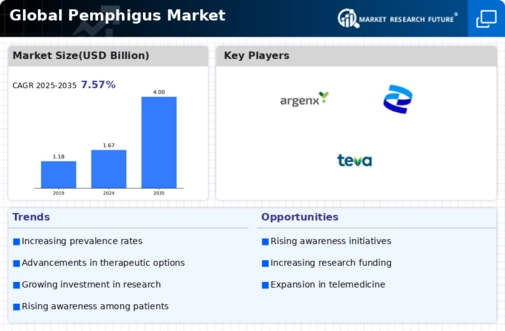Market Trends
Key Emerging Trends in the Pemphigus Market
The pemphigus market trends with regards to pemphigus vulgaris, an unusual autoimmune blistering disease that affects the skin and mucous membranes, have experienced significant changes in recent years. Pemphigus comes in several subtypes with pemphigus vulgaris and pemphigus foliaceus being the most common. One major development is the exploration of targeted therapies and biologicals. Traditionally, treatment strategies for pemphigus are rooted in systemic corticosteroids and immunosuppressive agents, but there’s a growing shift towards more specific interventions. Biologics such as rituximab which targets B cells involved in the autoimmune response have shown potential for controlling the disease without heavy reliance on systemic corticosteroids and thus limiting side effects that come along.
The dynamics of market trends within pemphigus are underpinned by advances in diagnosis. The advent of sophisticated immunological and molecular techniques has enhanced diagnostic accuracy and speed allowing clinicians to rapidly distinguish between different subtypes of pemphigus for appropriate initiation of therapy. Early intervention is crucial for management of pemphigus; it helps to prevent further progression of diseases thus improving patient outcomes.
Pemphigus is becoming relevant with telemedicine integration into digital health solutions. Telemedicine allows remote consultations from dermatologists and specialists creating convenience for patients who suffer from this disease. Using digital platforms to monitor progression of disease, track responses to treatment and improve patient education is a way forward towards obtaining paction-oriented care in Pemphigu especially during this COVID-19 pandemic.
Another trend observed within the pemphigus market involves combination therapies. Though corticosteroids remain fundamental agents in treating this condition, recent interest has grown on combinations with other immunomodulatory drugs or biologics designed to offer an improved control over diseases while minimizing undesirable side effects related to high dosage steroids. This trend bears in mind the acute phase of blister formation and underlying autoimmune processes during pemphigus management.
Research and development activities are shaping the pemphigus market in efforts to understand the immunopathogenesis of this condition as well as identify new targets for treatment. Academic institutions, pharmaceutical companies, and research organizations join forces together to explore innovative therapies such as targeted immunotherapies and gene-based interventions that may transform pemphigus care and enhance long-term effectiveness.
Patient advocacy has become increasingly important in the market for pemphigus. By raising awareness, providing resources, and creating a sense of community among those living with the condition, these organizations help individuals affected by pemphigus. Other functions include funding research initiatives while ensuring policies supporting access to novel treatments are being advanced thereby making an environment that paves ways for better support of people suffering from Pemphigus.
Regulatory considerations play an integral role in the pemphigus market as regulatory bodies actively evaluate safety and efficacy of new therapeutic interventions. In order to bring new innovative treatments for Pemphigu on the market more efficiently it is necessary to streamline approval processes by fostering collaboration between regulators, healthcare professionals, and industry stakeholders.
Global collaborations and partnerships have been observed within the pemphigus sector since it is a rare disease; therefore concerted efforts are needed to advance researches about it as well as its treatment options. Healthcare institutions work closely with pharmaceutical firms as well as advocacy groups so that comprehensive approaches can be taken towards addressing challenges associated with Pemphigu leading to collective patient care improvement outcomes.






Leave a Comment